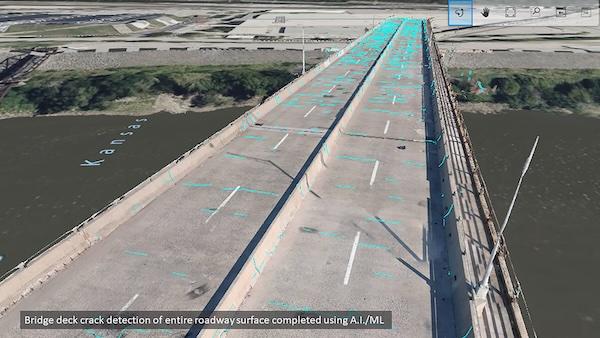Leveraging Bentley Infrastructure Cloud and iTwin Technology Streamlines Workflows and Facilitates Data-centricity to Save over 75% of Manual Field Work
Project Summary
Organization: Benesch
Solution: Surveying and Monitoring
Location: United States
Project Objectives:
- To streamline and automate pavement crack detection processes.
- To leverage AI/ML and digital twins for an intelligent, data-centric application to pavement assessment.
Project Playbook: iTwin, iTwin Capture
Fast Facts
- Traditional pavement management processes lack efficiency and comprehensiveness, failing to maximize asset value.
- Benesch explored integrating AI/ML and digital twins for a more data-centric, automated pavement detection workflow.
- Leveraging Bentley’s iTwin applications with AI/ML technologies, Benesch piloted a ground-breaking digital solution.
ROI
- The pavement crack detector technology saved 75% in onsite manual data collection.
- Benesch expects to save an estimated USD 144,000 when inspecting 100 future airports.
- The data-centric approach will save 99% of time for CAD users to digitize linework.
Pushing Technology Boundaries for Pavement Assessment Workflows
Most civil infrastructure assets—including bridges, transport networks, and airport runways—include pavement, requiring crack detection survey and maintenance to ensure the safety and longevity of these structures. However, current traditional pavement assessment practices and data collection methods are costly, time consuming, and result in shutdowns that negatively impact infrastructure owner-operators, as well as the public. “Our clients struggle with the amount of time that it takes consultants to close their assets down, and current methods for collecting cracking and joint data take too long,” said Bret Tremblay, technical manager at Benesch, a multidiscipline engineering firm offering services across a broad range of civil infrastructure markets. In addition, the on-site inspections and analyses would not be conducted for the entire pavement, but rather across sample sections, providing general insight into existing area damage and a projected average for defects throughout the rest of the asset. While this approach opens the door to quantity overruns and change orders, it has become standard industry practice.

Courtesy 1: Benesch explored integrating AI/ML and digital twins for a more data-centric, automated pavement detection workflow. Image courtesy of Benesch.







